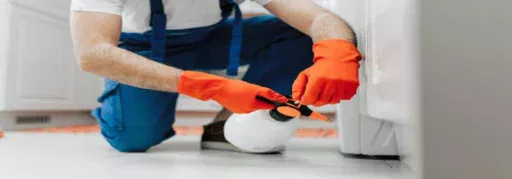When dealing with a mouse infestation, it’s crucial to recognize that even experienced exterminators can make mistakes. Many of these blunders stem from insufficient inspection practices, reliance on ineffective methods, or failure to educate clients on prevention. By being aware of these common mistakes, you can ensure a more effective treatment strategy for your home.
One prevalent error is neglecting thorough inspections before starting extermination. Skipping this step can lead to incomplete treatments and recurring infestations. Additionally, some exterminators may use one-size-fits-all approaches without considering each situation’s specific needs and circumstances, which can compromise effectiveness.
Finally, poor communication about preventive measures often leaves clients at risk of future infestations. You may not understand how to secure your home against reentry without proper guidance. Recognizing these common pitfalls allows you to choose the right exterminator and take proactive steps in maintaining a mouse-free environment.
Understanding Mouse Behavior and Habitat
When dealing with mice, it’s crucial to recognize their behavior and habitat preferences. Mice are nocturnal creatures, primarily active at night. Expecting them to leave during the day may lead to miscalculations.
Mice typically seek out areas that provide food, water, and shelter. They prefer cluttered spaces that offer hiding spots. Common habitats include:
- Basements
- Attics
- Wall voids
A common mistake made by mice exterminators is to focus solely on elimination while neglecting to identify and seal entry points. If you overlook these areas, mice will likely return.
Understanding their social structure is also important. Mice often live in groups, which means if you treat only part of the infestation, the remaining mice can easily repopulate.
It’s vital to use the right traps and baits. Avoid placing traps in the open where they might not be effective. Instead, place them along walls or high-traffic areas where you notice signs of activity.
Another mistake is relying solely on chemical solutions without addressing environmental factors. Maintaining cleanliness and reducing clutter can greatly help in prevention and control.
By understanding mouse behavior and habitat, you enhance your approach to extermination and ensure a more effective strategy.
Best Practices for Mice Extermination
Effective mice extermination requires a strategic approach to ensure success and minimize mistakes. Adopting the right assessment techniques and selecting appropriate extermination methods will facilitate thorough and effective mice removal.
Proper Assessment Techniques
Begin with a detailed inspection of the area. Look for signs of mice activity, including droppings, gnaw marks, and nests. Pay close attention to entry points, such as gaps in walls or around pipes.
Utilize tools like flashlights to illuminate dark areas and traps to gauge activity levels. Systematically document your findings. This information helps you understand the infestation’s scale and nature, guiding subsequent methods.
Collaboration is key. If you notice potential structural issues that could contribute to the mouse problem, involve a contractor to seal these entry points. Correct assessment lays the groundwork for successful extermination.
Choosing the Right Extermination Methods
Selecting the right extermination method is crucial for effective results. Options include traps, baits, and professional pest control services. Before deciding, evaluate the severity of the infestation.
Snap traps and humane traps can be effective for lighter infestations. For better effectiveness, be sure to place them in locations where you’ve observed mouse activity.
In more severe cases, consider bait stations, but use them cautiously. Always follow label instructions to avoid risks to pets and children. If you lack experience, hiring a professional pest control service may be your best choice. They have the skills to implement a comprehensive plan while avoiding common exterminator mistakes in Richardson.
Region-Specific Considerations
Understanding Richardson’s specific regional characteristics is crucial for effective mouse extermination. Local conditions and regulations can significantly influence your strategies, avoiding common mistakes and ensuring compliance with laws.
Adapting to Richardson’s Environment
Richardson’s climate features hot summers and mild winters, which impacts mouse activity. During warmer months, mice may seek cooler indoor shelter, increasing infestation risks.
You should focus on sealing entry points effectively. Common mistakes include overlooking small gaps in doors, windows, and foundations. Regularly inspecting these areas can prevent infestations.
It is also essential to strategically place bait stations. Place them in shaded areas to protect them from the sun, ensuring the bait remains effective. Be aware that the local food supply, like bird feeders, attracts mice. By acknowledging these environmental factors, you enhance your extermination methods.
Compliance with Local Regulations
Familiarity with local regulations is vital to avoid legal issues. In Richardson, pest control practices must adhere to Texas Department of Agriculture guidelines.
Understanding proper baiting and trapping methods prevents violations. Using prohibited substances can lead to fines and liability, so always check which chemicals are approved.
Documentation is another key area. You should keep records of all treatments and permits. Many exterminators neglect this, leading to compliance issues. Training your team on local laws and best practices can prevent these errors, ensuring professional and responsible extermination services.
Common Pitfalls in Mice Extermination
Effective mice extermination requires careful planning and execution. Here are common pitfalls you should avoid:
- Ignoring Entry Points: Failing to identify and seal all entry points allows mice to re-enter after removal. Inspect your property thoroughly.
- Ineffective Bait Placement: Placing bait in the wrong locations can lead to ineffective trapping. Use targeted areas where you observe mouse activity.
- Relying Solely on Poison: Using poison can be hazardous to pets and children. Consider humane options that effectively remove mice without risk.
- Neglecting Sanitation: Allowing food residues and clutter increases the attraction for mice. Keep your space clean and store food properly.
- Underestimating Population Size: Misjudging the number of mice can lead to inadequate treatment. Assess the situation accurately to determine the necessary approach.
Avoiding common exterminator mistakes is crucial for successful pest management in Richardson. Consider hiring experts to ensure all steps are followed correctly.
For effective wildlife and pest removal, contact Critter Stop at (214) 234-2616 for a free inspection. Critter Stop has a fantastic reputation and online customer reviews because it provides high-quality work and great customer service.
Read More Article here : https://talkingspree.com/best-movie-to-enjoy-on-streaming-platform-hdhub4u/






